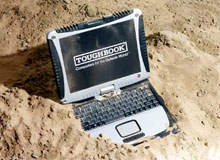
Ruggedised notebooks are the latest products intended to not just meet, but exceed, personnel expectations out in the field. Notebook computers for consumer and business use are at best ‘durable’ or ‘semi-rugged’ rather than fully rugged – what this means is that they’re slightly less fragile than the non-durable versions.
Conversely, truly rugged notebooks are expected to meet a variety of international standards and specifications, the most common being MIL-STD-810F and IP54. MIL-STD-810F is a 539-page US military standard of rating aerospace and ground-deployed equipment for use in battle conditions, according to the item’s ability to withstand such factors as vibration, shock and extremes of humidity and temperature.
No more than five units of a particular model being tested may be submitted to complete the tests in order to pass MIL-STD-810F.
This means that four out of five units may fail any one test for the model and still be awarded the standard. Nevertheless, MIL-STD-810F is the accepted standard and imposes conditions way beyond the capabilities of your average laptop.
The tests include spraying water at 50kPa–150kPa at a rate of 10l a minute from 30cm to 50cm away from the unit for one hour, dropping the unit 90cm onto a plywood surface (on a total of 26 different edges, corners or surfaces) and shaking the unit at 20Hz–1,000Hz in different axes for one hour, to simulate the vibrations induced during in-vehicle travel.
See Also:
Also, the units must be dusted with 2kg of talcum per cubic metre at
15°C–30°C and 25%–75% humidity for eight hours, do five operation cycles at
-10°C–50°C for 24 hours, and 72 hours non-operational at -35°C–75°C. As if that wasn’t enough, for their final trick testers place the units in temperatures moving between 20°C and 60°C with relative humidity of 95% for five 48-hour cycles, repeated every 24 hours.
How well do you really know your competitors?
Access the most comprehensive Company Profiles on the market, powered by GlobalData. Save hours of research. Gain competitive edge.

Thank you!
Your download email will arrive shortly
Not ready to buy yet? Download a free sample
We are confident about the unique quality of our Company Profiles. However, we want you to make the most beneficial decision for your business, so we offer a free sample that you can download by submitting the below form
By GlobalDataIP54 is about how well the enclosure is protected. A 1mm body must not be able to penetrate the enclosure and dust must not be able to enter in sufficient quantities for the equipment to stop operating safely and satisfactorily.
BUILT FOR A LICKING
Some of the rugged laptops that meet both standards and are considered suitable for military use. Keyboards are sealed and protected against water, while the screen itself has a secondary protection layer in front of the LCD.
Many also feature a magnesium alloy shell and a case of acrylonitrile butadiene styrene (ABS) compound that’s 20 times stronger than traditional notebook plastics.
ABS is an oil-based polymer that exhibits strength, rigidity and toughness at -25°C–60°C. Certain grades, with more polybutadiene, have higher impact resistance. It can be attacked by some strong chemicals, including acetone and concentrated sulphuric or nitric acids, and is about twice as expensive as the more commonly used polystyrene.
Instead of having a rigid connector for the daughter board or hard drive, some have a flexible one that better absorbs impact. And the case is honeycombed to provide greater strength, with components insulated from each other as much as possible.
Rugged notebook vendors also try to incorporate fewer moving parts – such as solid-state drives and special heatsink mesh for cooling, instead of relying on fragile fans that also let dust and dirt inside. Rubber corners and covers further add to the imperviousness of the unit.
Many also have new ‘transflective’ LCD technology that makes the screens readable even in bright sunlight – not exactly a ‘rugged’ feature but necessary if the unit is to be used outdoors.
Hardware that is rugged by design has internal components and cases engineered right from the start for computing in harsh conditions. Prominent military-grade brands include Akhter, Panasonic, Getac, TerraLogic, Azonix, DRS Technologies and General Dynamics Itronix.
FUTURE SHOCK
Defence personnel can expect to see ruggedised notebooks in the near future that incorporate more multimedia functionality, especially telephony that will let users harness voice-over-internet in the field, and they can expect to see them smaller, lighter and essentially more portable in an attempt to keep up with the rugged PDAs and ultra-mobile PCs (UMPCs) we’re already seeing.
Although vendors weren’t keen on releasing specifics far ahead of launch, it’s expected that ruggedised notebooks will follow a similar trajectory to their softer cousins – that means, above all, the drive to make things smaller, lighter and faster.
In the business and consumer space, all eyes are on the release of the first service pack for Windows Vista operating system – forecast to iron out some of the most irritating behaviours of Microsoft‘s latest operating system. Of course, that will affect rugged releases too.
Look for improved security features, even biometrics and boosted wireless capabilities. 2008 will see technologies appear that are compliant with the new wireless 802.11n standard, and major brands begin to include WiMAX processing capabilities in their laptops. Ruggedised notebooks will soon get even tougher as well – a MIL-STD-810G has been in the pipeline for over a year. When that standard is finalised, expect to see the vendors jump into line.







